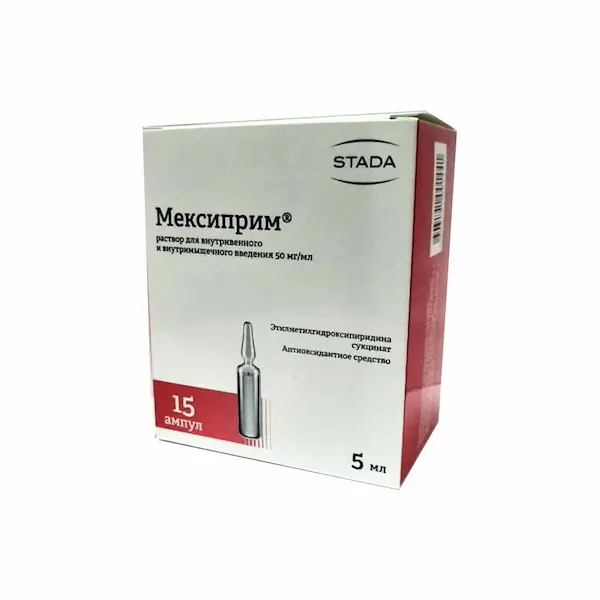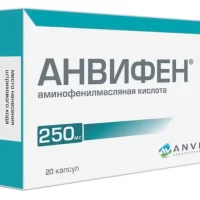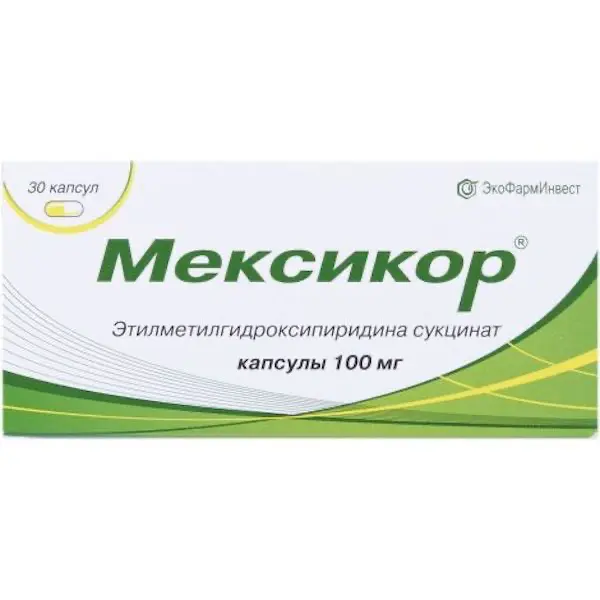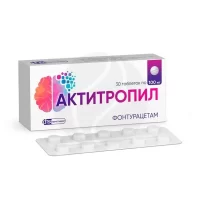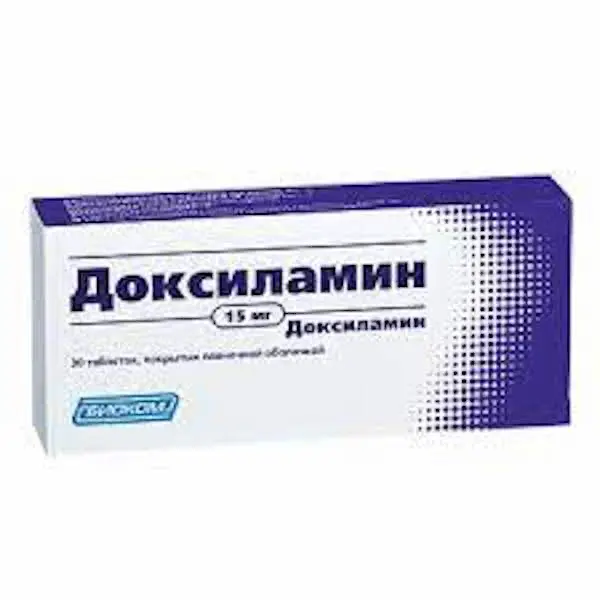Description
Mexiprim Pharmacodynamics
An antioxidant agent, a 3-oxypyridine derivative, has an antihypoxic, membrane-protective, nootropic, anticonvulsant, stress-protective, and anxiolytic effect. The drug increases the body’s resistance to the effects of major damaging factors, to oxygen-dependent pathological states (shock, hypoxia and ischemia, impaired cerebral circulation, intoxication with alcohol and antipsychotic drugs (neuroleptics)).
The mechanism of action of ethylmethylhydroxypyridine succinate is due to its antioxidant, antihypoxant and membrane-protective effects. The drug reduces the manifestations of oxidative stress, inhibits lipid peroxidation, increases superoxide dismutase activity, increases the lipid-protein ratio, improves the structure and function of cell membranes. The drug modulates the activity of membrane-bound enzymes (calcium-independent phosphodiesterase, adenylate cyclase, acetylcholinesterase), receptor complexes (benzodiazepine, GABA, acetylcholine) that enhance their ability to bind to ligands, contribute to maintaining the structural and functional organization of biomembranes, neurotransport and improve synaptic transmission. The drug increases the content of dopamine in the brain. It causes enhancement of compensatory activation of aerobic glycolysis and reduction of inhibition of oxidative processes in the Krebs cycle under hypoxia with increase of adenosine triphosphate (ATP) and creatine phosphate, activation of energy-synthesizing functions of mitochondria, stabilization of cell membranes.
Ethylmethylhydroxypyridine succinate normalizes metabolic processes in ischemic myocardium and improves its functional state, reduces the zone of necrosis, restores and improves myocardial electrical activity and contractility, as well as increases coronary blood flow in the ischemic zone, reduces the consequences of reperfusion syndrome in acute coronary failure. In conditions of coronary insufficiency increases collateral blood supply of ischemic myocardium, promotes preservation of integrity of cardiomyocytes and maintenance of their functional activity. Effectively restores myocardial contractility in reversible cardiac dysfunction. Increases the antianginal activity of nitropreparations.
Improves metabolism and blood supply to brain tissues, improves microcirculation and rheological properties of blood, reduces platelet aggregation. Stabilizes membrane structures of blood cells (erythrocytes and platelets). It has hypolipidemic effect, reduces the content of total cholesterol and low-density lipoproteins.
It promotes preservation of retinal ganglion cells and optic nerve fibers at progressive neuropathy caused by chronic ischemia and hypoxia. It improves functional activity of the retina and optic nerve, increasing visual acuity.
The drug reduces enzymatic toxemia and endogenous intoxication in acute pancreatitis.
Indications
Acute disorders of cerebral circulation (as part of complex therapy);
Craniocerebral trauma, consequences of craniocerebral injuries;
discirculatory encephalopathy;
vegetative dystonia syndrome;
Mild cognitive disorders of atherosclerotic genesis;
Anxiety disorders in neurotic and neurosis-like conditions;
Acute myocardial infarction (from the first day of treatment as part of complex therapy);
Primary open-angle glaucoma of different stages, as part of the treatment;
management of withdrawal syndrome in alcoholism with a predominance of neurosis-like and autonomic-vascular disorders;
acute intoxication with antipsychotic agents;
Acute pyo-inflammatory processes of the abdomen (acute necrotizing pancreatitis, peritonitis) as part of the treatment.
Contraindications .
Increased individual sensitivity to the drug. Acute hepatic and/or renal failure.
Due to lack of data on efficacy and safety – childhood, pregnancy, breast-feeding.
Administration during pregnancy and breast feeding period
Mexiprim® administration during pregnancy and breast feeding is contraindicated because of absence of data about efficiency and safety of drug administration during these periods.
Dosage and administration method
- Intramuscularly or intravenously (by stream or drop). When administering by infusion method the drug should be diluted in 0.9% sodium chloride solution. The drug shall be administered slowly for 5-7 minutes by jetting, or by drip infusion at the rate of 40-60 drops per minute.
- Dosing regimen shall be selected individually. Maximum daily dose shall not exceed 1200 mg.
- Acute cerebral circulation disorders (as part of complex therapy): first 10-14 days, IV drops of 200-500 mg 2-4 times daily, then intramuscularly 200-250 mg 2-3 times daily for 2 weeks.
- Craniocerebral trauma, consequences of craniocerebral injuries: 200-500 mg intravenously drip 200-500 mg 2-4 times a day for 10-15 days.
- Dyscirculatory encephalopathy in decompensation phase: intravenously by jet or dropwise in dose 200-500 mg 1-2 times daily during 14 days; then – intramuscularly in dose 100-250 mg daily during next 2 weeks.
- Course prophylaxis of discirculatory encephalopathy: intramuscularly in a dose of 200-250 mg 2 times a day during 10-14 days.
- Autonomic dystonia syndrome, neurotic and neurosis-like conditions:
Intramuscularly 50-400 mg daily for 14 days. - Mild cognitive impairment of atherosclerotic genesis (in elderly patients), anxiety disorders: intramuscularly 100-300 mg per day for 14-30 days.
- Acute myocardial infarction (from the first day as part of complex therapy): intravenously or intramuscularly for 14 days; the drug is used against standard therapy of myocardial infarction, including nitrates, beta-adrenoblockers, angiotensin-converting enzyme (ACE) inhibitors, thrombolytics, anticoagulants and antiaggregants, and symptomatic drugs by prescription.
- In the first 5 days, to achieve maximum effect, the drug is administered intravenously, in the next 9 days the drug may be administered intramuscularly.
- Intravenous administration is performed by drop infusion, slowly (in order to avoid side effects) for 30-90 minutes (in 100-150 ml of 0.9% sodium chloride solution or 5% dextrose (glucose) solution). If necessary, slow (duration of at least 5 min) intravenous stream administration of the drug is possible.
- The drug is administered (intravenously or intramuscularly) 3 times a day every 8 hours.
- The daily dose is 6-9 mg/kg of body weight, the single dose is 2-3 mg/kg of body weight.
- The maximum daily dose should not exceed 800 mg, a single dose – 250 mg.
- Primary open-angle glaucoma of various stages (as part of complex therapy): intramuscularly 100-300 mg daily; 1-3 times a day for 14 days.
- Withdrawal alcohol syndrome: intramuscularly or intravenously dropwise at a dose of 200-500 mg 2-3 times a day for 5-7 days.
- Acute intoxication with antipsychotic drugs: intravenously in a dose of 200-500 mg per day for 7-14 days.
- Acute pyo-inflammatory processes of abdominal cavity (acute necrotizing pancreatitis, peritonitis): as part of complex therapy the drug is prescribed during the first day both pre- and postoperatively. Administered doses depend on the form and severity of the disease, process prevalence, variants of the clinical course. Drug should be withdrawn gradually only after a sustained positive clinical and laboratory effect.
- In acute edematous (interstitial) pancreatitis, the drug is prescribed 200-500 mg 3 times daily, intravenously by drip (in 0.9% sodium chloride solution) and intramuscularly.
- Mild degree of necrotic pancreatitis – 100-200 mg three times a day, intravenously by drop (in 0.9% sodium chloride solution) and intramuscularly. Moderate severity – 200 mg 3 times a day, intravenously drip (in 0.9% sodium chloride solution). A heavy course – in a dosage of 800 mg during the first day, twice a day; then 200-500 mg twice a day with a gradual reduction of the daily dose. Extremely severe course – in initial dosage of 800 mg daily until stable relief of pancreatogenic shock; after stabilization, 300-500 mg 2 times daily by intravenous drip (in 0.9% sodium chloride solution) with gradual reduction of daily dose.

